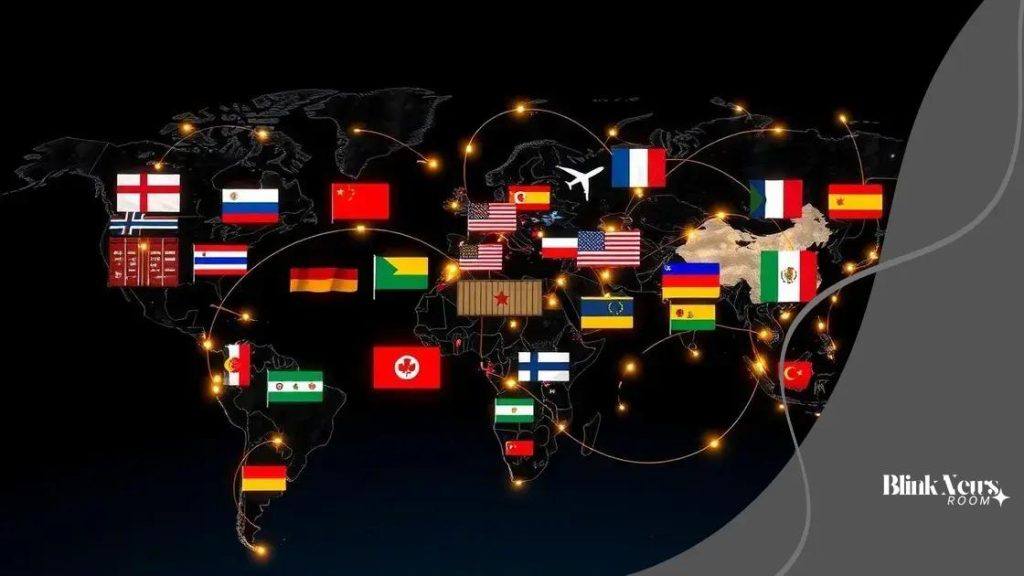Global trade agreements: unlocking international markets

Anúncios
Global trade agreements are treaties that facilitate trade by reducing tariffs and barriers, fostering economic growth, and creating opportunities for collaboration among nations while addressing challenges like compliance and geopolitical tensions.
Global trade agreements play a crucial role in shaping the economic landscape. Have you ever wondered how these agreements affect your daily life and the products you purchase? Let’s dive deeper into this compelling topic.
Anúncios
Understanding global trade agreements
Understanding global trade agreements is essential in today’s interconnected world. These agreements facilitate trade between countries, aiming to reduce barriers and foster cooperation.
By examining their purpose, we can see how they function to create a more open market. The primary aim of these agreements is to enhance trade relations and stimulate economic growth.
Types of Global Trade Agreements
Different types of trade agreements exist, each with unique features:
Anúncios
- **Bilateral Agreements:** Agreements between two countries to promote trade.
- **Multilateral Agreements:** Involves multiple countries working together towards trade and economic cooperation.
- **Free Trade Agreements:** Aim to eliminate tariffs and trade restrictions between members.
Understanding these types is crucial because they influence how goods and services flow between countries. When countries enter into a free trade agreement, they often see an increase in exports and imports, boosting their economies.
Benefits of Understanding Trade Agreements
Being informed about global trade agreements allows businesses and individuals to navigate international markets effectively. Some benefits include:
- Gaining access to new markets
- Lowering costs for consumers and businesses
- Encouraging investment
Additionally, understanding how these agreements work can empower consumers to make informed choices about products and services. As trade barriers decrease, consumers often enjoy a wider variety of goods at lower prices.
Countries also benefit from cooperation on trade regulations, which helps to standardize practices and promote fairness. This cooperation fosters trust among nations and can lead to further collaborative efforts in areas like environmental protection and labor rights.
To sum up, having a grasp on global trade agreements equips individuals and businesses with the knowledge they need to thrive in a global economy. The interconnected nature of today’s markets means that understanding these agreements can provide a competitive advantage for nations and companies alike.
Key benefits of global trade agreements
Exploring the key benefits of global trade agreements reveals how these agreements impact economies positively. Businesses and consumers alike stand to gain from reduced trade barriers, increased access to foreign markets, and a broader selection of available products.
One significant advantage is the reduction of tariffs. When tariffs are lowered, imported goods become cheaper, leading to more affordable prices for consumers. This enables families to save money while obtaining a wide variety of goods.
Expanded Market Opportunities
Global trade agreements also open doors to new market opportunities for exporters.
- Increase in export sales
- Access to larger customer bases
- Enhanced competitiveness in global markets
With greater market access, companies can expand their reach and boost their sales. This expansion can lead to economic growth not only for the businesses involved but also for the economy of their home country.
Promotion of Foreign Investment
Another notable benefit is the promotion of foreign investment. Nations that engage in global trade agreements often create a favorable climate for investors. Here are some reasons why:
- Stability and predictability in trade rules
- Protection of intellectual property rights
- Encouragement of sectoral collaboration
These factors create a more appealing environment for international businesses, which can lead to job creation and technological advancement in host countries.
Furthermore, global trade agreements foster cooperation among nations. Countries collaborating on trade issues often work together on challenges like environmental protection and labor rights. This collaboration cultivates diplomatic relationships that can lead to peace and understanding between nations.
Challenges associated with global trade agreements

Understanding the challenges associated with global trade agreements is crucial for anyone involved in international trade. These agreements can be beneficial, but they also come with significant obstacles.
One major challenge is the issue of compliance. Countries must adhere to the terms of the agreement, which can sometimes lead to disputes. For example, if one country does not follow the rules, it can negatively impact trade relationships.
Economic Disparities
Another challenge is the economic disparities between nations. Global trade agreements can favor wealthier countries, creating an uneven playing field for developing nations.
- Limited access to technology.
- Tariff advantages for developed nations.
- Impact on local industries.
These disparities can lead to feelings of resentment and can hinder successful cooperation among countries. Developing nations often struggle to keep up with the competitive advantages held by wealthier nations.
Political Factors
Political factors also play an essential role in the effectiveness of global trade agreements. Changes in government policies or leadership can impact existing agreements.
- Shifting political priorities.
- Domestic opposition to trade agreements.
- Potential for protectionist policies to arise.
These political changes can create instability, which complicates trade relationships. Sometimes countries may renegotiate agreements, causing confusion and uncertainty.
Moreover, the complexity of legal regulations can be daunting. Countries have different laws and regulations regarding trade, which can create barriers to smooth transactions. Navigating these laws requires understanding and resources that not all businesses have.
Case studies of successful trade agreements
Examining case studies of successful trade agreements provides valuable insights into how these agreements can boost economies and strengthen international relationships. Different examples show the benefits and effectiveness of trade agreements worldwide.
One notable case is the North American Free Trade Agreement (NAFTA). This agreement, signed in 1994, eliminated tariffs between the United States, Canada, and Mexico. As a result, trade between these countries grew significantly. By 2018, exports from the U.S. to Mexico increased threefold, strengthening economic ties.
European Union Trade Agreements
The European Union (EU) provides another excellent example of successful trade agreements. The EU operates as a single market, allowing for free movement of goods, services, people, and capital among member states.
- Elimination of tariffs enhances trade.
- Standard regulations improve competition.
- Access to a larger consumer market boosts business growth.
Businesses in the EU benefit from lower costs and increased investment opportunities, leading to economic stability across member countries. The cooperation among countries within the EU has also been crucial for responding to global challenges more effectively.
Comprehensive and Progressive Agreement for Trans-Pacific Partnership (CPTPP)
Another significant case study is the Comprehensive and Progressive Agreement for Trans-Pacific Partnership (CPTPP), which includes countries like Japan, Canada, and Australia. This agreement promotes free trade and economic integration among its members. The CPTPP sets high standards for labor and environmental protections, showcasing how trade agreements can also address social issues.
Since its implementation, member countries have experienced increased trade flows. For instance, Australia saw an export increase of agricultural products to Japan, demonstrating the tangible benefits of the agreement.
These case studies highlight the potential of successful trade agreements to promote economic growth, improve international relations, and facilitate cooperation among countries.
Future trends in global trade agreements
Analyzing future trends in global trade agreements allows us to understand how international commerce may evolve. Several factors are shaping what these agreements will look like in the coming years.
One significant trend is the move towards more digital trade agreements. As e-commerce continues to grow, nations recognize the need to create rules that support digital transactions. These agreements often focus on issues like data privacy, cybersecurity, and cross-border data flows.
Incorporation of Sustainability
Another emerging trend is the incorporation of sustainability within trade agreements. Countries are beginning to prioritize environmental protection and worker rights in their negotiations.
- Increased focus on climate change.
- Implementation of environmental standards.
- Promotion of fair labor practices.
This shift reflects a growing awareness that trade should not come at the expense of the environment or human rights. Countries that embrace sustainable practices can often gain a competitive advantage in global markets.
Regional Trade Agreements
Furthermore, regional trade agreements are becoming more prominent. These agreements allow neighboring countries to collaborate more closely, creating stronger economic ties. For instance, the African Continental Free Trade Area (AfCFTA) aims to integrate economies across Africa significantly.
Such agreements can lead to the elimination of tariffs and promote intra-regional trade. This strategy helps smaller economies benefit from larger markets, thus spurring economic development.
As geopolitical tensions rise, protectionist sentiments may also affect future trade agreements. Countries might become hesitant to enter into agreements that may put their economies at risk. This could lead to a trend of bilateral agreements, where countries negotiate directly without broader multilateral participation.
In summary, the future of global trade agreements will likely be shaped by digitalization, sustainability efforts, regional collaborations, and a cautious approach to international relations.
FAQ – Frequently Asked Questions about Global Trade Agreements
What are global trade agreements?
Global trade agreements are treaties between countries that outline the terms of trade, reducing tariffs and other barriers to strengthen economic relationships.
What are the benefits of global trade agreements?
They lead to reduced costs for consumers, expanded markets for businesses, and increased economic growth through improved trade relations.
What challenges do global trade agreements face?
Challenges include compliance issues, economic disparities between nations, and political factors that may disrupt trade relations.
What trends are shaping the future of trade agreements?
Future trends include a focus on digital trade, sustainability efforts, and the growth of regional collaborations among countries.